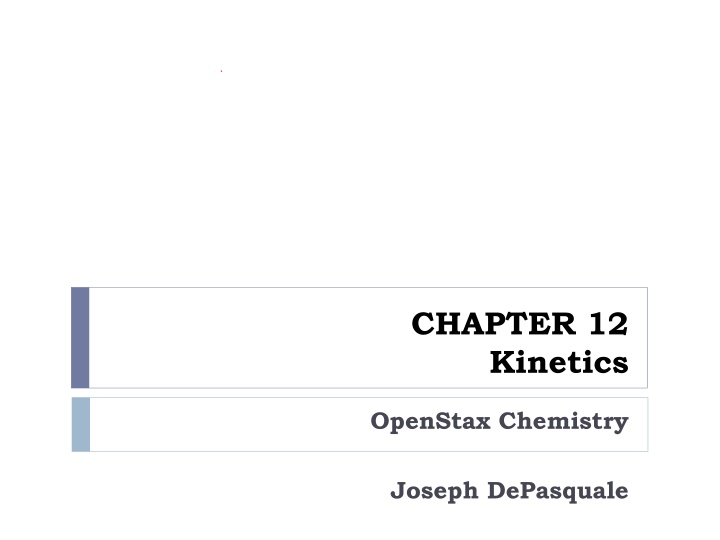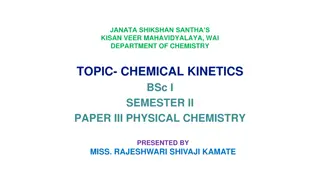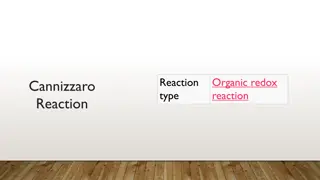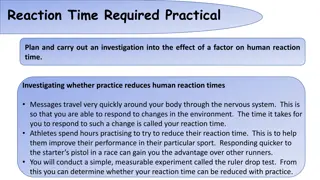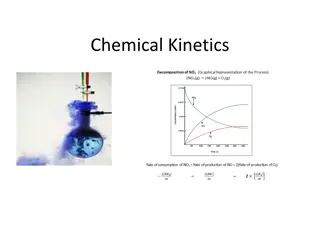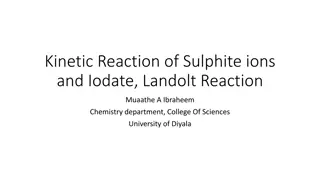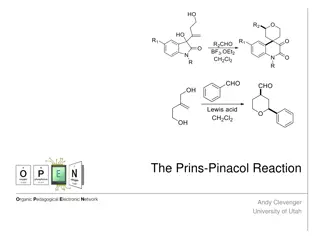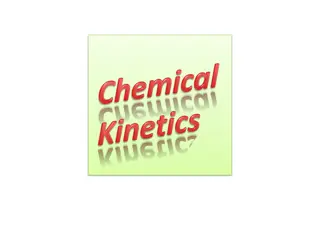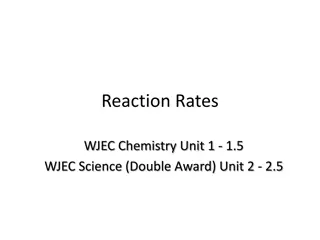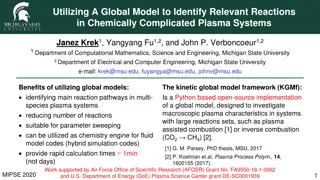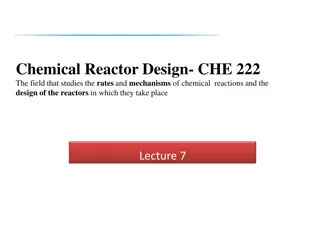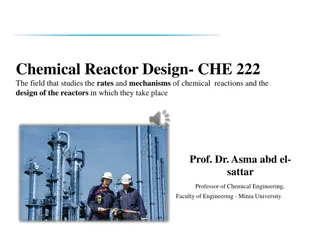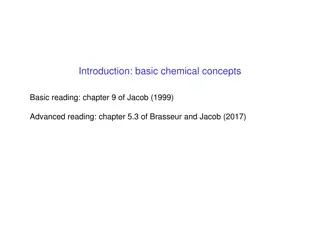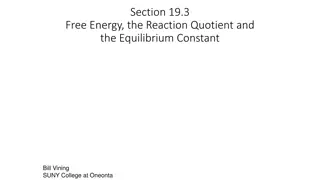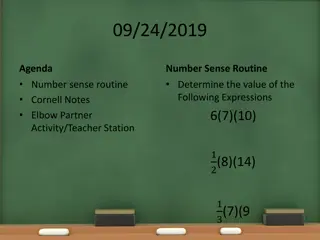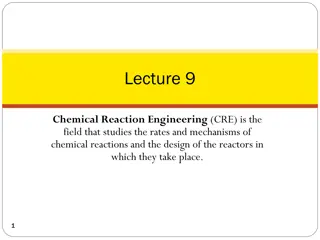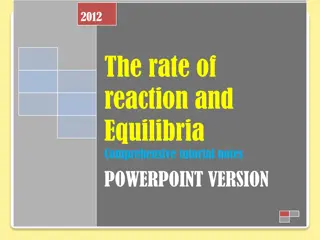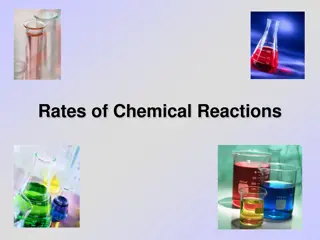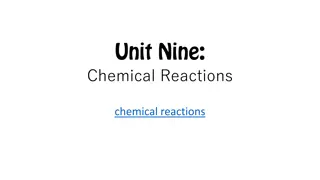Chemical Reaction Rates and Expressions
Chemical reactions occur at different rates, with reactions being classified as fast or slow. The study of reaction rates, known as Kinetics, involves examining factors that affect rates and controlling them. Rate expressions are mathematical representations of reaction rates, typically expressed in terms of concentration and molarity. This study explores average, instantaneous, and initial reaction rates, along with determining different rates of reaction and relative rates based on stoichiometric factors derived from balanced equations.
Download Presentation

Please find below an Image/Link to download the presentation.
The content on the website is provided AS IS for your information and personal use only. It may not be sold, licensed, or shared on other websites without obtaining consent from the author.If you encounter any issues during the download, it is possible that the publisher has removed the file from their server.
You are allowed to download the files provided on this website for personal or commercial use, subject to the condition that they are used lawfully. All files are the property of their respective owners.
The content on the website is provided AS IS for your information and personal use only. It may not be sold, licensed, or shared on other websites without obtaining consent from the author.
E N D
Presentation Transcript
CHAPTER 12 Kinetics OpenStax Chemistry Joseph DePasquale
Outline 12.1: Chemical Reaction Rates 12.2: Factors Affecting Reaction Rates 12.3: Rate Laws 12.4: Integrated Rate Laws 12.5: Collision Theory 12.7: Catalysis Omit section 12.6
12.1: Chemical Reaction Rates Chemical reactions occur at different rates. Some reactions are fast, while other reactions are slow. Chemists study the rates of reactions and also try to control these rates. The study of reaction rates is known as Kinetics. 3
12.1 Chemical Reaction Rates The rate of a reaction is the change in the amount of a reactant or product per unit time. It is often convenient to express amount in terms of concentration. Rate Expression: Mathematical Representation of rate of reaction.
Rate Expressions Reaction rates are always positive quantities. Concentration is most often expressed in Molarity. Rate expressions can be written in terms of reactant or product concentration.
Writing Rate Expressions 2N2O5(g) 4NO2(g) + O2(g) Write the rate expression in terms of each species. Rate of N2O5 decomposition = Rate of NO2 formation = Rate of O2 formation =
Average vs. Instantaneous Reaction Rates AverageReaction Rate The rate at which a reaction proceeds over a time period. Calculated using concentrations at the beginning and end of a time period. InstantaneousReaction Rate The rate at which a reaction is proceeding at a specific time and/or conc. Calculated using a graph (Conc. vs. time) and a slope of a straight line tangent to the curve at that specific time. Or by determining the avg. rate of reaction over a very short time period. Initial Reaction Rate The instantaneous reaction rate at time zero .
Determining Different Rates of Reaction 2H2O2(aq) 2H2O(l) + O2(g)
Relative Rates of Reaction The rate of a reaction may be expressed in terms of the change in concentration of any reactant or product. Stoichiometric factors derived from a balanced equation may be used to relate reaction rates.
12.2: Factors Affecting Reaction Rates 1) Chemical nature of the reactants. Example: As you move down a group the alkali metals react at a faster rate with water. https://www.youtube.com/watch?v=jI__JY7pqOM
12.2: Factors Affecting Reaction Rates 2) The state of subdivision of the reactants. The rate of most reactions increase with increasing surface area contact between reactants.
12.2: Factors Affecting Reaction Rates 3) Temperature of the reactants. Reaction rate ordinarily increases with temperature. 4) Concentration of the reactants. Reaction rate ordinarily increases with the concentration of reactants. 5) The presence of a catalyst
Rate and Collision Chemical reactions occur as the result of collisions between reactant molecules. The higher the concentration of reactant molecules, the more likely molecules will collide and react, and therefore the faster the reaction rate. https://www.youtube.com/watch?v=m4_twEXWjgg As reactants get consumed, collisions happen less frequently and the reaction rate decreases.
12.3: Rate Laws Rate is directly related to reactant concentration. 14
Rate Laws N2O5 (g) 2NO2 (g) + O2 (g) The rate law for this reaction is: Rate = k[N2O5] Only reactants appear in a rate law. k is the rate constant for the reaction. The rate law is used to calculate the instantaneous rate or initial rate of reaction with a specific reactant concentration. For some reactions the rate law is more complex
Rate Constant, k The rate constant, k is specific for a particular reaction at a particular temperature. k is independent of reactant concentration. k must be determined experimentally.
Rate Laws Experiments must be done to determine the rate law for a reaction. Can t just use a balanced chemical equation. For a reaction with a single reactant A products Rate = k[A]m m is the order of the reaction m must be determined experimentally (not from balanced chemical equations). Reaction orders are usually positive integers (0, 1, 2 ) but can also be fractions or negative numbers. 17
Rate Laws Most reactions involve more than one reactant. A + B products Rate = k[A]m[B]n There are three orders: m is the order with respect to A n is the order with respect to B The overall order of the reaction = m + n 18
Order with respect to a reactant The order with respect to a reactant indicates the dependence of the reaction rate on the concentration of that particular reactant. The overall order gives an understanding of how all the reactants contribute to the rate of a reaction. Also, dictates the units of the rate constant for that reaction.
Determination of a Reactions Rate Law One way to determine the rate law of a reaction is to measure the initial rate. The rate at time zero. If the initial rate is measured with a number of different initial reactant concentrations then the rate law can be determined.
How to Determine a Rate Law The order with respect to a particular reactant can be determined by varying its initial concentration while holding the initial concentration(s) of the other reactant(s) constant. Experimentally measure the initial rate with each of the two different concentrations. The change in rate is then a direct result of the reactant which changed in concentration. The order with respect to that reactant can then be calculated. Repeat this process with all reactants. 21
12.4 Integrated Rate Laws So far we have only talked about the concentration-rate relationship. A products Rate = k[A]m The rate law can be integrated with respect to time to produce a concentration-time relationship know as an integrated rate law. This relationship depends on the order of the reaction: Zero order, 1st order, 2nd order, etc. A new term, the half-life, will also be introduced. 22
First-Order Reactions For 1st order reactions of the type A products Rate = k[A] [ ]0 [ ]t A A Integration with respect to time gives us: = kt ln k is the rate constant t is time [A]0 is the initial reactant conc. [A]t is the reactant conc. present at time t
Linear form of the First-Order Integrated Rate Law A [ ]0 A [ ]t = kt ln We can put the first-order integrated rate law into the form ln A [ ]t= -kt + ln A [ ]0 y = mx + b ln[A]t plotted on the y axis time (t) plotted on the x axis The slope of the line is k The y-intercept is ln[A]0
Integrated Rate Laws Note that when using all of the integrated rate laws [ ]0 A [ ]t A ln A [ ]t= -kt + ln A [ ]0 = kt ln The amount of reactant (A) does not always need to be expressed in Molarity (M) as the equations imply. The amount can also be expressed in Mass (g, mg, etc.) Number of molecules or atoms Other conc. units such as g/L Partial pressure if A is a gas (assuming volume and temperature remain constant).
The Half Life: First Order Reaction The half life (t1/2) of a reaction is the time it takes for one half of a given amount of reactant to be consumed. For a first order reaction, at the half life, t1/2 [A]t = [A]0 Solving for t in ln[A]t = -kt + ln[A]0 t1/2=ln 2 =0.693 k k
The Half Life: First Order Reaction t1/2=ln 2 =0.693 k k Notice that for a first order reaction, the half life is independent of the initial concentration of reactant.
Second-Order Integrated Rate Law For A products, Rate = k[A]2 Integration with respect to time gives us: The half-life of a second order reaction does depend on the initial concentration of reactant.
Zero Order Integrated Rate Law For a zero order reaction: A Products Integration with respect to time gives us: Note that the half life of a zero order reaction DOES DEPEND on the initial concentration of reactant.
12.5 Collision Theory Collision Theory Reactants (atoms, molecules, or ions) must collide in order to react with each other. Postulates of Collision Theory: 1) Rate of Reaction is proportional to the rate of reactant collisions.
Collisions: Effective and Ineffective Why does every collision not lead to a reaction? 2) Molecules must be oriented properly when they collide.
Collisions: Effective and Ineffective Why does every collision not lead to a reaction? 3) Molecules must have adequate kinetic energy to react. The kinetic energy supplied must be high enough to break the chemical bonds. Molecules with kinetic energies too small just bounce off each other and don t react. This required energy is called the activation energy Activation Energy (Ea) minimum energy necessary to form a product during a collision between reactants.
Transition-State Model Reaction Energy diagram Potential energy is plotted on the y-axis Reaction path (or extent of reaction) is plotted on the x-axis. The reactants form an intermediate called an activated complex. The state of the system at the activated complex is called a transition state 33
Reaction Rate and Temperature Thus far we have discussed The concentration-rate relationship The concentration-time relationship Now we will look at the temperature rate relationship Reaction rate ordinarily increases with temperature. To cook food more quickly, raise the oven temperature. To slow the reactions that lead to food spoilage, put food in the refrigerator. To really slow the reactions down, put food in the freezer.
Kinetic Theory Temperature is a measure of the average kinetic energy of molecules. Higher temperatures mean higher kinetic energies. The higher the temperature, the larger the fraction of molecules with kinetic energies equal to or greater than the activation energy (Ea). With a larger fraction of molecules possessing Ea, a larger fraction of collisions lead to product formation, resulting in a higher rate of reaction. 35
Consider the following equation: k = Ae Ea/RT A is a constant called called the frequency factor and is related to the frequency of collision and orientation. The rate constant (k) is dependent on the activation energy of the reaction and the temperature.
k = AeEa/RT Consider two different reactions that occur at the same temperature. Each reaction has a different Ea.
k = AeEa/RT Consider the same reaction at two different temperatures. Ea is independent of temperature.
The area under the curve is directly proportional to the number of molecules possessing those energies.
Arrhenius Equation k = Ae Ea/RT Taking the natural logarithm of both sides of the equation gives the Arrhenius Equation. -Ea R 1 ln(k) = +ln(A) T
Two-point form of the Arrhenius Equation =Ea lnk2 1 T1 1 k1 R T2 This form of the Arrhenius equation can be used with two k values and two corresponding temperatures to calculate Ea. You do not need to know the value of the constant, A, to use this equation. Make sure that the energy units on Ea and R are identical.
12.7 Catalysis Catalyst A substance that increases the rate of a chemical reaction by lowering the activation energy without itself being consumed by the reaction. The catalyst is regenerated in the process. Catalysts provide an alternate reaction pathway with a lower activation energy. Sometimes the catalyzed path contains multiple steps, but each individual step has an activation energy that is lower than the activation energy of the uncatalyzed reaction.
Types of Catalysts 1) A Homogeneous catalyst is in the same phase as the reactants. It speeds up the reaction by forming a reactive intermediate. The reactive intermediate reacts further to form product and regenerate the catalyst. The reactive intermediate is formed but immediately consumed.
Homogeneous catalyst Example: Chlorine radicals (Cl) that catalyze the decomposition of ozone. Cl(g) + O3(g) ClO(g) + O2(g) ClO(g) + O(g) Cl(g) + O2(g)
Types of Catalysts 2) A Heterogeneous catalyst is in a different phase from that of the reactants. Most commonly the catalyst is a solid and the reactants are in the gas or liquid phase. Example is the catalytic converter in automobiles which consists of platinum and rhodium metals. Pt 2CO(g) + O2(g) CO2(g) Rh NO(g) N2(g) + O2(g)
Types of Catalysts 3) Enzymes are biocatalysts Protein molecules
